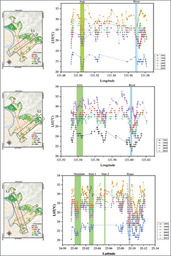Behind the Scenes of the "Quality of Life and Social Change" Handbook
Published in Sustainability, Education, and Economics
Creating a handbook as comprehensive and multifaceted as Quality of Life and Social Change was an interesting journey. This project, rooted in the POZE paradigm, dives deeply into understanding the many dimensions of human existence and how individual well-being interconnects with collective societal change. While on the surface, it may seem like a typical academic compilation, this handbook is far more: it is a call to action, a roadmap for change, and a celebration of the intricate web that connects individuals to their communities, countries, and the planet at large.
The journey of developing this handbook was driven by the ambition to answer four fundamental questions: What is quality of life? Where are the entry points to nurture it? Who is involved? And why is change needed now? But, beyond these questions, the creation process itself offered insights into the shifting nature of life, society, and the invisible forces that shape both.
The Inspiration Behind the Handbook
The POZE paradigm underpins the entire handbook, offering a holistic perspective on life that considers the interaction of soul, heart, mind, and body at the individual level, alongside the micro (individual), meso (community), macro (national), and meta (planetary) levels at the collective level. This dynamic framework allows readers to see life not as a fragmented series of events but as an evolving kaleidoscope where individual actions ripple through to affect larger systems. This philosophy was not just a theoretical backdrop for the authors but guided every aspect of the handbook's creation.
The handbook emerged from a desire to offer practical solutions to long-standing societal challenges. While the world often looks to economic and technological innovations to solve social problems, the contributors to this handbook understood that true, sustainable social change must be rooted in human connections, aspirations, and the shared desire for well-being. In other words, improving quality of life requires us to first understand what it means to thrive—both individually and collectively.
The Process: A Collaboration Across Disciplines
One of the most compelling aspects of the handbook is its diversity—both in terms of the contributors and the perspectives it offers. Drawing from a wide range of academic and practical fields, the handbook features contributions from experts in behavioral science, policy, education, and environmental studies, among others. This interdisciplinary approach mirrors the multidimensional nature of the issues at hand.
Each chapter is a unique reflection of the author’s personal and professional journey, highlighting the individual paths that led them to this collective endeavor. For many contributors, the project became more than just an academic exercise. It provided an opportunity for self-reflection, enabling them to explore their own beliefs about the role of humans in driving social change and enhancing the quality of life for all.
This convergence of perspectives adds a rich texture to the handbook, demonstrating that social change cannot be approached from a one-size-fits-all perspective. Each chapter represents a different piece of the puzzle, revealing the nuances of how individual actions can create collective impact.
A Holistic Approach to Social Change
The handbook seeks to illustrate the complex, interconnected challenges of today’s world. Its structure follows a logical flow, guiding readers through various dimensions of social change, starting from individual-level interventions (micro), to community-based approaches (meso), up to national policies (macro), and global challenges (meta).
At the heart of the handbook is the belief that everything is connected. The interplay between individual well-being and collective societal change is not just theoretical but can be observed in everyday life. For example, individual aspirations, emotions, thoughts, and sensations directly influence how people engage with their communities, and in turn, these communities shape broader societal norms and policies. The book posits that by improving quality of life on a micro level, positive ripple effects can reach the meso, macro, and meta levels of society.
Yet, this transformation requires on the one hand individual desire. On the other hand, It demands systems thinking, policy changes, and the conscious alignment of human actions with broader goals of equity and sustainability. This is where the POZE paradigm provides a useful lens because it offers a way to navigate life’s challenges, embrace its inherent changes, and optimize the potential of every human interaction to contribute to social good.
The POZE Paradigm: Guiding Change
The POZE framework—standing for Perspective, Optimization, Zeniths, and Exposure (but also for 'inner peace' in Haitian Creole, where it was initially prototyped) —is more than just a guiding philosophy in this handbook. It is a practical tool that individuals and institutions can use to better understand their role in fostering social change. The handbook’s introduction and conclusion serve as bookends to this framework, reiterating the core belief that quality of life and social change are inseparable.
In this context, Perspective refers to recognizing the interconnectedness of all aspects of life and acknowledging that every action, no matter how small, has a broader impact. Optimization is about improving not just oneself but the systems in which we live and work. Zeniths represent the aspirational high points that individuals and communities strive for, and Exposure relates to the openness required to experience and embrace the constant change that life entails.
Practical Applications and the Path Forward
In many ways, the handbook is a reflection of the times. It acknowledges that we live in an era of rapid technological change, growing inequality, and environmental crises. Yet, rather than focusing on the problems, it offers a vision for how we can navigate these challenges through conscious actions at both the individual and collective levels.
The conclusion of the handbook summarizes this sentiment beautifully, noting that lasting social change stems from individuals who not only make change but also become change. It emphasizes that by embracing our shared humanity and recognizing the inherent potential in every person, we can create a more equitable and thriving world. Importantly, the handbook challenges the outdated notion of vulnerability, encouraging readers to see it as an untapped strength rather than a weakness.
The handbook also provides numerous practical examples of how ProSocial AI, behavioral science, and other innovative tools can be leveraged to enhance quality of life and foster social change. Whether through AI-powered therapies, intelligent tutoring systems, or community-based data analytics, the handbook demonstrates that the future of social change lies in harnessing human potential alongside cutting-edge innovations.
Final Thoughts: An Invitation to Reflect and Act
This behind-the-scenes look at the Quality of Life and Social Change handbook reveals a project born out of deep collaboration, thoughtful reflection, and an unwavering commitment to making the world a better place. It invites readers to not only learn from the perspectives shared but to actively engage in the process of change—whether at the individual, community, national, or planetary level.
In the end, the handbook is not just a resource for understanding quality of life—it is a blueprint for action. It reminds us that every step toward improving individual well-being is a step toward a more just and sustainable world.





Please sign in or register for FREE
If you are a registered user on Research Communities by Springer Nature, please sign in